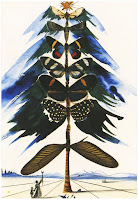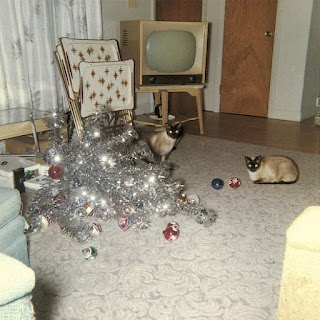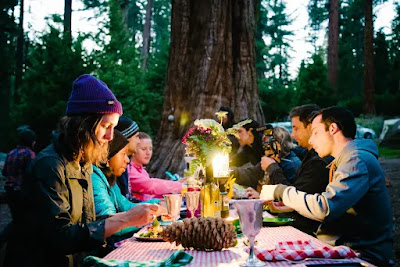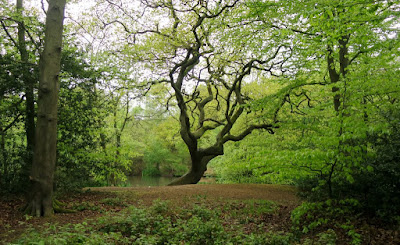For many people, the idea that trees can be haunted is preposterous. But for millions of others, it seems as natural as the changing seasons. I’ve written previously about
how entwined humans are with trees and this close connection extends into the spiritual realm for many. This is not a new or radical idea. Our ancestors were firm believers – everyone from the
ancient Romans and Egyptians to the Celts and Native Americans, and millions in between, saw trees as spirit homes.
Tree spirits are very much a part of cultures around the world (here is a partial list of just some of them). Nowhere is this truer than in India. This vast and complicated country has one commonality that covers all the geographical and cultural regions: The apparent infestation of ghosts in their trees and the acceptance of their presence by locals. Indian ghosts have a preference for particular trees – specifically the fig, banyan, neem, and tamarind. Here is a quick and fun read that illustrates how ghosts are assimilated into everyday life by a family in Kolkata in northern India and here is a cool story about ghosts in southern India.

Silk Cotton trees (aka kapok trees) have a uniquely spooky presence to many people in the Caribbean. They say these trees are haunted because so many slaves (and some criminals) were hung from them. Others say the ghostly spirits were always there. This belief in kapok spirits can be traced back to the West African roots of the enslaved people brought to this region, where this tree is considered sacred (read more here). In an interesting cross-oceanic parallel, the ancient Mayan also saw this tree as sacred. In their tradition, the first human came from a kapok tree.
Almost anyone can be turned into a tree ghost believer if they look long and closely enough at a tree. It is easy to see things there. Whether we invent what we want to see or the spirits are showing themselves is up for discussion.
Here is one explanation of why we see faces in trees. A compelling example of this phenomenon is the following story: In the spring of 2017, a storm came through Rochester, NY, and left behind some unusual damage. It tore a large piece out of a tree in Durand-Eastman Park, exposing what looked to be the figure of a woman holding a baby (although not everyone sees the baby part). What makes this particularly unique is that for decades this area has been haunted by sightings of a woman in white, called the White Lady or the Lady of the Lake. She is said to be searching for her lost baby. Could her spirit have been trapped in this tree all this time? Check out the pictures
here; they’re pretty impressive.
Around the world, there are whole forests that are deemed haunted (see some here). Often it is easy to understand why this designation has evolved – they are places that have seen the whole of the human experience over eons, or they are the sights of bloody battles or fascinating events. But, sometimes they just seem creepy for no definable reason. Here are some examples of singularly spooky trees:
In New Jersey, there is an oak tree called the Basking Ridge Devil’s Tree. This particular tree has a wealth of stories swirling around it about ghostly goings-on, supposed-curses, demonic activity and more. People claim it’s where the Ku Klux Klan practiced rituals, it’s a portal to hell, a driverless truck will chase you down if you get near it, it’s haunted by a man who murdered his family, and even that if you touch it
your hands will turn black if you eat at a restaurant. If you are still interested in visiting this now-protected (from the public or on behalf of the public) tree,
here are directions.
In Northern Ireland (another culture with a great affinity for supernatural beings) the village of Finnis, County Down, has a haunted sycamore tree that has been a resident there since the early years of the 20th century. Before that time, there had been a nasty little spirit pestering people around their bridge over the river. A priest eventually trapped it in a bottle and put it in the tree. No one has messed with that tree since. Even powerlines were re-routed around it. See it and read more about it here.

Sometimes haunted trees produce more than just goosebumps. In the case of an apple tree in Franklin, Connecticut, its flowers and fruit tell a haunting tale. The story goes that in the mid-1750s, a farmer murdered a peddler and buried him under an apple tree. In some versions of the story, the farmer can’t handle the guilt and hangs himself from the same tree. No matter the version, when the trees bloomed in the spring the flowers were crimson-red instead of white, and when the apples appeared they had strange, blood-colored flesh. The actual tree in question most likely was downed by a hurricane in 1938, but these apples (known as Micah Rood apples) are still in existence. Some of this story is true, some is not and some may be. Go here to learn more.
Not all haunted trees are old or scary-looking. In many parts of Southeast Asia, the frangipani tree is thought to house ghosts, and worse. While these beautiful and fragrant trees are appreciated for just those things, according to Malay (still widely believed) folklore, if you get a sudden whiff of their fragrance a
Pontianak may be nearby. These are vengeful lady vampire spirits that seduce and kill. In Thailand and Vietnam, this tree is associated with death and the unhappy ghosts that live in them.

In the US, live oaks are a favorite for ghosts. Wherever there is a spectacular old specimen, there seem to be ghost stories hovering around it. This is the case for a spectacularly beautiful, nearly 500-year-old live oak on St. John’s Island in South Carolina that has become as famous for its haunts as for its beauty. Known as the Angel Oak, this glorious tree rises up 65 feet with branches that spread out over 17,000 square feet. It needs all that room for the thriving population of ghostly beings that call it home. Well before colonizers appeared on this shore, the Native Americans were aware of the power of this tree. They buried their dead around it and those spirits are some that abide here. Once a part of a plantation, there are the understandably restive souls of slaves that had been hung from its branches. And that’s just some of the ghosts. Learn
more
here or see a video
here.
Whether you call them spirits or ghosts or something else entirely, it seems clear that trees have a presence that is unique to each individual. And, like all individuals in a larger whole, not all of them are nice.
Take Care.
Submitted by Pam






















































